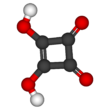This is an old revision of this page, as edited by ZéroBot (talk | contribs) at 12:36, 3 January 2012 (r2.7.1) (Robot: Adding nl:Kwadraatzuur). The present address (URL) is a permanent link to this revision, which may differ significantly from the current revision.
Revision as of 12:36, 3 January 2012 by ZéroBot (talk | contribs) (r2.7.1) (Robot: Adding nl:Kwadraatzuur)(diff) ← Previous revision | Latest revision (diff) | Newer revision → (diff)
| |||
| Names | |||
|---|---|---|---|
| IUPAC name 3,4-Dihydroxycyclobut-3-ene-1,2-dione | |||
| Other names Quadratic acid | |||
| Identifiers | |||
| CAS Number | |||
| 3D model (JSmol) | |||
| ChemSpider | |||
| ECHA InfoCard | 100.018.875 | ||
| PubChem CID | |||
| CompTox Dashboard (EPA) | |||
InChI
| |||
SMILES
| |||
| Properties | |||
| Chemical formula | C4H2O4 | ||
| Molar mass | 114.06 g/mol | ||
| Appearance | Gray powder | ||
| Melting point | >300 °C | ||
| Hazards | |||
| Flash point | 190 °C | ||
| Except where otherwise noted, data are given for materials in their standard state (at 25 °C , 100 kPa).
| |||
Squaric acid, also called quadratic acid, because its four carbon atoms approximately form a square, is an organic compound with chemical formula Template:Carbon4Template:Hydrogen2Template:Oxygen4.
The conjugate base of squaric acid is the hydrogensquarate anion C4HO4; and the conjugate base of the hydrogensquarate anion is the divalent squarate anion C4O4. This is one of the oxocarbon anions, which consist only of carbon and oxygen.
Squaric acid is a reagent for chemical synthesis, used for instance to make photosensitive squaraine dyes and inhibitors of protein tyrosine phosphatases.
Chemical properties
Squaric acid is a white crystalline powder with a melting point of 293 °C. The structure of squaric acid is not a perfect square, as the carbon–carbon bond lengths are not quite equal.
The high acidity with pKa = 1.5 for the first proton and pKa = 3.4 for the second is attributable to resonance stabilization of the anion. Because the negative charges are equally distributed between each oxygen atom, the dianion of squaric acid is completely symmetrical (unlike squaric acid itself) with all C-C and C-O bond lengths identical.
Another, quantum mechanical, way of describing the dianion is to assume that the π electrons of the two double-bonded oxygen atoms are shifted to the latter, so that all four oxygens become single-bonded -O groups and a double positive electric charge is left in the ring of carbon atoms. In this way the ring fits Hückel's rule for aromaticity (2 π-electrons = 4n + 2 with n = 0). The total symmetry of the dianion is a consequence of charge distribution and aromaticity.
On the other hand, theoretical calculations indicate that the analogous tetrathiosquarate anion C
4S
4 is anti-aromatic.
Derivatives
Cobalt(II) squarate hydrate Co(C4O4)(H2O)2 (yellow, cubic) can be prepared by autoclaving cobalt(II) hydroxide and squaric acid in water at 200 °C. The water is bound to the cobalt atom, and the crystal structure consists of a cubic arrangement of hollow cells, whose walls are either six squarate anions (leaving a 7Å wide void) or several water molecules (leaving a 5 Å void).
Cobalt(II) squarate dihydroxide Co3(OH)2(C4O4)2 3H2O (brown) is obtained together with the previous compound. It has a columnar structure including channels filled with water molecules; these can be removed and replaced without destroying the crystal structure. The chains are ferromagnetic; they are coupled antiferromagnetically in the hydrated form, ferromagnetically in the anhydrous form.
The same method yields iron(II) squarate dihydroxide Fe2(OH)2(C4O4) (light brown).
One or both of the oxygen (=O) groups in the squarate anion can be reasplaced by other chalcogenides such as sulfur or other divalent groups, such as dicyanomethylene =C(CN)2. The resulting anions, such as 1,2-bis(dicyanomethylene)squarate and 1,3-bis(dicyanomethylene)squarate, retain the aromatic character of squarate and have been called pseudo-oxocarbon anions. There have been theoretical investigations of the analogous compound obtained by substituting amino groups (-NH2) for the hydroxyl (OH) groups to yield 1,2-diamino-3-cyclobutenedione, and of a compound consisting of two squarate rings bridged by (-NH-) bonds to form bis(3-cyclobutene-1,2-dione)piperazine.
Syntheses
The original synthesis started from reaction of 1-chloro-1,2,2-trifluoroethylene with zinc to perfluorocyclobutene. This compound was converted to 1,2-diethoxy-3,3,4,4-tetrafluoro-1-cyclobutene with ethanol. Hydrolysis gives the squaric acid.
Squarate and related anions such deltate C
3O
3 and acetylenediolate C
2O
2 have been obtained from carbon monoxide under mild conditions by reductive coupling of CO ligands in organouranium complexes. A similar route recently afforded carbonate anions (in the form of uranium(IV) carbonate) from carbon dioxide CO2.
Medical uses
Medically, squaric acid dibutylester is used for the treatment of warts. Squaric acid dibutylester is also used treating alopecia areata or alopecia totalis/universalis (autoimmune hair loss) through topical immunotherapy involving the production of an allergic rash.
See also
- Cyclobutene, C
4H
6 - Deltic acid, C
3H
2O
3 - Croconic acid, C
5H
2O
5 - Rhodizonic acid, C
6H
2O
6
References
- 3,4-Dihydroxy-3-cyclobutene-1,2-dione. Sigma-Aldrich
- 3,4-Dihydroxy-3-cyclobutene-1,2-dione, 98+%. Alfa Aesar
- Robert West and David L. Powell (1963), New Aromatic Anions. III. Molecular Orbital Calculations on Oxygenated Anions J. Am. Chem. Soc. volume 85 issue 17, pages 2577–2579.
- Reza Ghiasi and Majid Monajjemi (2007), Theoretical study of interaction of alkaline earth metal with C
4O
4 and C
4S
4: structure, electronic properties and aromaticity. Journal of Sulfur Chemistry, Volume 28, Issue 6, pages 537–546 doi:10.1080/17415990701561263 - ^ Hitoshi Kumagai, Hideo Sobukawa, and Mohamedally Kurmoo (2008), Hydrothermal syntheses, structures and magnetic properties of coordination frameworks of divalent transition metals. Journal of Materials Science volume 43, pages 2123–2130. doi:10.1007/s10853-007-2033-8
- Zhao-Ming Xue, Jian-Jun Cheng, and Chun-Hua Chen (2006), Theoretical study of the gas-phase acidity and aromaticity of a novel derivative of nitrogen squaric acid . Journal of Molecular Structure: THEOCHEM, Volume 763, Issues 1–3, pages 181–186 doi:10.1016/j.theochem.2006.01.026
- J. D. Park, S. Cohen, and J. R. Lacher (1962). "Hydrolysis Reactions of Halogenated Cyclobutene Ethers: Synthesis of Diketocyclobutenediol". J. Am. Chem. Soc. 84 (15): 2919–2922. doi:10.1021/ja00874a015.
{{cite journal}}: CS1 maint: multiple names: authors list (link) - Alistair S. Frey, F. Geoffrey N. Cloke, Peter B. Hitchcock (2008), Mechanistic Studies on the Reductive Cyclooligomerisation of CO by U(III) Mixed Sandwich Complexes; the Molecular Structure of 2(μ-η:η-C2O2) Journal of the American Chemical Society, volume 130, issue 42, pages 13816–13817. doi:10.1021/ja8059792
- Owen T. Summerscales, Alistair S. P. Frey, F. Geoffrey N. Cloke, and Peter B. Hitchcock (2009), Reductive disproportionation of carbon dioxide to carbonate and squarate products using a mixed-sandwich U(III) complex. Chemical Communications, pages 198–200 doi:10.1039/b815576c
- Warts. Wilmingtondermatologycenter.com. Retrieved on 2011-10-23.
- A. M. Holzer, L. L. Kaplan, W. R. Levis (2006). "Haptens as drugs: contact allergens are powerful topical immunomodulators". J. Drugs. Dermatol. 5 (5): 410–416. PMID 16703776.
{{cite journal}}: CS1 maint: multiple names: authors list (link)

